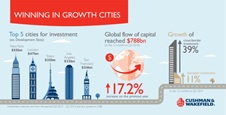by Brianna Crandall — November 7, 2014—New York attracted the most commercial real estate investment during the last year as the global real estate investment market saw volumes increase by 17.2% to U.S.$788 billion, according to Cushman & Wakefield’s annual Winning in Growth Cities report launched last month at EXPO REAL in Munich, Germany. While a number of cities still dominate, activity is spreading to an increased number of global markets as investors relax their risk tolerance.
 The top five cities for investment are New York City, London, Tokyo, Los Angeles and San Francisco.
The top five cities for investment are New York City, London, Tokyo, Los Angeles and San Francisco.(Click on image to enlarge)
New York saw $55.4 billion invested in the year to Q2 2014 — this equates to 7% of global market share. London, which registered $47.3 billion of investment, closed the gap on New York thanks to a 40.5% increase in activity; it is also the largest global market for cross-border investors. Tokyo ($35.5 billion) reclaimed third position from Los Angeles ($33.1 billion) which dropped into fourth, while San Francisco completes the top five ranked cities with $23.8 billion invested.
Cushman & Wakefield’s International CEO, Carlo Barel di Sant’Albano, commented, “Competition, growth and change will bring forth more new global winners. While gateway cities remain a primary focus for investors, interest in a broader spread of locations is increasingly apparent due to improved confidence and finance availability as well as a lack of supply in core cities. Risk appetites have expanded in the US and buyers in Europe and Asia are following suit, particularly where local partners can be found.
“Looking forward to 2015, the global economy is anticipated to be firmer but still vulnerable, with trends divergent country-by-country. One of the most notable drivers for this will be the polarization in monetary policy, which will be tightening in some areas but remaining loose elsewhere.”
The top 10 cities for global investment changed little from last year, with the exception of Dallas moving into 9th at the expense of Houston (11th). Shanghai, Beijing, Miami and Stockholm joined the top 20, while Toronto, Singapore, Moscow and Seoul fell out. Dubai and Dublin saw significant change and leaped into the top 50 from 186th and 82nd position, respectively. Top cities continue to be popular across multiple sectors, with New York top in retail, multifamily and hospitality; London top for offices; Los Angeles top for industrial; and Tokyo a top-five market in retail, office and industrial.
The report also states competition to buy will continue to push up prices, with prime yields down 13 basis points (bp) globally to 7% last year and likely to at least match this in the year ahead.
Cross-border investment
Cross-border investment rose by 38.8% last year compared to an 11.3% growth in domestic spending, as international investors once again increased their market share. While Europe remains the biggest area for foreign investment, it saw a 35% growth in cross-border buying last year; growth has actually been more rapid in the Americas (46%) and Asia (43%), underlining the truly global nature of the marketplace.
London remains by far the most favored market with a 14.1% share versus 5.5% for Paris and 4.9% for New York. Overall, 13 of the top 30 are in EMEA, nine are in Asia, seven in North America, and one in Latin America. The fastest growth was in Beijing, rising from 46th to 17th place, followed by Boston, Amsterdam, Madrid and Sao Paulo.
The biggest source of cross-border capital was the Americas, with $75.3 billion invested non-domestically, while Europeans are the number two international buyer, but a significant share of this is targeted within the region. American investors were the strongest players outside their own region last year, with $58.7 billion invested, 48% of the global total.
The fastest growing stream of international investment however has been Asian capital flowing out of the region. Asian global investment rose 56% last year compared to a 54% increase by American investors, 26% by Europeans, and 13% by Middle Eastern and African players.
Typically, Asian players cross borders easily, but much in the past has been within their own region. That has changed dramatically in recent years as Asian businesses have diversified abroad, focusing initially on gateway cities in the United States and the United Kingdom, but now spreading their net more widely, says the report.
Winning in Growth Cities 2014-2015 is available from the C&W Web site.





